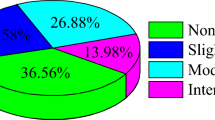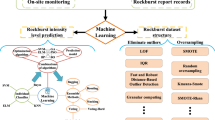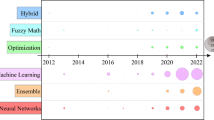Abstract
Rockburst has become one of the most serious threats to the safety of workers, equipment, and excavations in deep underground engineering. However, short-term rockburst risk prediction remains an unsolved problem. This study aims to propose five ensemble classifiers to estimate the probability of short-term rockburst risk. These ensemble classifiers adopted the logistic regression, naive Bayes, Gaussian process, multilayer perceptron neural network, support vector machines, and decision tree as base learners, and used the average-based, accuracy-based, precision-based, recall-based and F1-based combination rules, respectively. A total of 91 rockburst samples collected from the tunnels of Jinping II hydropower station, which included seven microseismic indicators, were used to verify the feasibility of the proposed ensemble classifiers. The comprehensive performance of each ensemble classifier was compared and evaluated using the accuracy and macro average of the precision, recall and F1 metrics. In addition, the effects of different combinations of indicators on the prediction results were analyzed. Because of the favorable predictive performance, the proposed ensemble classifiers were applied to predict the short-term rockburst risk in different locations of the same project. The probability of each risk level was calculated, and then the final short-term rockburst risk was determined based on the highest probability. The results show that the comprehensive performance of the proposed ensemble classifiers is better than each base learner, and the accuracy-based and the F1-based ensemble classifiers can be preferentially selected to predict the short-term rockburst risk. The highest accuracy and macro average of the precision, recall and F1 metric values are 0.8667, 0.8901, 0.8661 and 0.8779, respectively. The proposed ensemble classifiers can provide valuable guidance for predicting the short-term rockburst risk.










Similar content being viewed by others
References
Afraei S, Shahriar K, Madani SH (2019) Developing intelligent classification models for rock burst prediction after recognizing significant predictor variables, Section 1: literature review and data preprocessing procedure. Tunn Undergr Sp Tech 83:324–353
Alcott JM, Kaiser PK, Simser BP (1998) Use of microseismic source parameters for rockburst hazard assessment. Pure Appl Geophys 153:41–65
Brady BT, Leighton FW (1977) Seismicity anomaly prior to a moderate rock burst: a case study. Int J Rock Mech Min 14:127–132
Cai W, Dou LM, Zhang M, Cao WZ, Shi JQ, Feng LF (2018) A fuzzy comprehensive evaluation methodology for rock burst forecasting using microseismic monitoring. Tunn Undergr Sp Tech 80:232–245
Di Franco G, Marradi A (2013) Factor analysis and principal component analysis. FrancoAngeli, Milan
Doan HT, Foody GM (2007) Increasing soft classification accuracy through the use of an ensemble of classifiers. Int J Remote Sens 28(20):4609–4623
Du PJ, Xia JS, Zhang W, Tan K, Liu Y, Liu SC (2012) Multiple classifier system for remote sensing image classification: a review. Sensors 12(4):4764–4792
Durrheim RJ (2010) Mitigating the risk of rockbursts in the deep hard rock mines of South Africa: 100 years of research. In: Brune J (ed) Extracting the science: A century of mining research, Society for Mining, Metallurgy, and Exploration, Littleton, pp 156–171
Durrheim RJ, Cichowicz A, Ebrahim-Trollope R, Essrich F, Goldbach O, Linzer LM, Spottiswoode SM, Stankiewicz T (2007) Guidelines, standards and best practice for seismic hazard assessment and rockburst risk management in South African mines. In: Proceeding of the 4th international seminar on deep and high stress mining, Perth, pp 249–261
Feng XT, Chen BR, Zhang CQ, Li SJ, Wu SY (2013) Mechanism, warning and dynamic control of rockburst development processes. Science Press, Beijing
Feng GL, Feng XT, Chen BR, Xiao YX, Yu Y (2015) A microseismic method for dynamic warning of rockburst development processes in tunnels. Rock Mech Rock Eng 48(5):2061–2076
Feng GL, Xia GQ, Chen BR, Xiao YX, Zhou RC (2019) A method for rockburst prediction in the deep tunnels of hydropower stations based on the monitored microseismicity and an optimized probabilistic neural network model. Sustainability 11(11):3212
Fernández-Delgado M, Cernadas E, Barro S, Amorim D (2014) Do we need hundreds of classifiers to solve real world classification problems. J Mach Learn Res 15(1):3133–3181
Frid V, Vozoff K (2005) Electromagnetic radiation induced by mining rock failure. Int J Coal Geol 64(1–2):57–65
Heal D, Hudyma M, Potvin Y (2006) Evaluating rockburst damage potential in underground mining. In: Proceedings of the 41st US Symposium on Rock Mechanics (USRMS), Golden, pp 1020–1025
Hirata A, Kameoka Y, Hirano T (2007) Safety management based on detection of possible rock bursts by AE monitoring during tunnel excavation. Rock Mech Rock Eng 40(6):563–576
Hosseini N (2017) Evaluation of the rockburst potential in longwall coal mining using passive seismic velocity tomography and image subtraction technique. J Seismol 21(5):1101–1110
Hudyma M, Potvin YH (2010) An engineering approach to seismic risk management in hardrock mines. Rock Mech Rock Eng 43(6):891–906
Jiang BY, Wang LG, Lu YL, Wang CQ, Ma D (2016) Combined early warning method for rockburst in a deep island, fully mechanized caving face. Arab J Geosci 9(20):743
Keneti A, Sainsbury BA (2018) Review of published rockburst events and their contributing factors. Eng Geol 246:361–373
Krawczyk B, Minku LL, Gama J, Stefanowski J, Woźniak M (2017) Ensemble learning for data stream analysis: a survey. Inf Fusion 37:132–156
Kumar P (2019) Machine learning quick reference. Packt Publishing Ltd., Birmingham
Leveille P, Sepehri M, Apel DB (2017) Rockbursting potential of kimberlite: a case study of Diavik diamond mine. Rock Mech Rock Eng 50(12):3223–3231
Li XL, Wang EY, Li ZH, Liu ZT, Song DZ, Qiu LM (2016) Rock burst monitoring by integrated microseismic and electromagnetic radiation methods. Rock Mech Rock Eng 49(11):4393–4406
Li N, Zare Naghadehi M, Jimenez R (2020) Evaluating short-term rock burst damage in underground mines using a systems approach. Int J Min Reclam Environ 34(8):531–561
Liang WZ, Zhao GY, Wang X, Zhao J, Ma CD (2019a) Assessing the rockburst risk for deep shafts via distance-based multi-criteria decision making approaches with hesitant fuzzy information. Eng Geol 260:105211
Liang WZ, Zhao GY, Wu H, Dai B (2019b) Risk assessment of rockburst via an extended MABAC method under fuzzy environment. Tunn Undergr Sp Tech 83:533–544
Liang WZ, Sari YA, Zhao GY, McKinnon S, Wu H (2020) Rockburst dataset in tunnels. Mendeley Data. https://doi.org/10.17632/t9m76twr72.1
Liu JP, Feng XT, Li YH, Sheng Y (2013) Studies on temporal and spatial variation of microseismic activities in a deep metal mine. Int J Rock Mech Min Sci 60:171–179
Lu CP, Dou LM, Zhang N, Xue JH, Wang XN, Liu H, Zhang JW (2013) Microseismic frequency-spectrum evolutionary rule of rockburst triggered by roof fall. Int J Rock Mech Min Sci 64:6–16
Lu CP, Liu GJ, Liu Y, Zhang N, Xue JH, Zhang L (2015) Microseismic multi-parameter characteristics of rockburst hazard induced by hard roof fall and high stress concentration. Int J Rock Mech Min Sci 76:18–32
Ma TH, Tang CA, Tang LX, Zhang WD, Wang L (2015) Rockburst characteristics and microseismic monitoring of deep-buried tunnels for Jinping II Hydropower Station. Tunn Undergr Sp Tech 49:345–368
Ma X, Westman E, Slaker B, Thibodeau D, Counter D (2018) The b-value evolution of mining-induced seismicity and mainshock occurrences at hard-rock mines. Int J Rock Mech Min Sci 104:64–70
Moreno-Seco F, Inesta JM, De León PJP, Micó L (2006) Comparison of classifier fusion methods for classification in pattern recognition tasks. Joint IAPR International Workshops on Statistical Techniques in Pattern Recognition (SPR) and Structural and Syntactic Pattern Recognition (SSPR). Springer, Berlin, pp 705–713
Mutke G, Dubiński J, Lurka A (2015) New criteria to assess seismic and rock burst hazard in coal mines. Arch Min Sci 60(3):743–760
Naji AM, Emad MZ, Rehman H, Yoo H (2019) Geological and geomechanical heterogeneity in deep hydropower tunnels: a rock burst failure case study. Tunn Undergr Sp Tech 84:507–521
Ortlepp WD, Stacey TR (1994) Rockburst mechanisms in tunnels and shafts. Tunn Undergr Sp Tech 9(1):59–65
Pedregosa F, Varoquaux G, Gramfort A, Michel V, Thirion B, Grisel O, Blondel M, Prettenhofer P, Weiss R, Dubourg V, Vanderplas J, Passos A, Cournapeau D, Brucher M, Perrot M, Duchesnay E (2011) Scikit-learn: machine learning in Python. J Mach Learn Res 12:2825–2830
Rasskazov IY, Migunov DS, Anikin PA, Tereshkin AA, Zhelnin DO (2015) New-generation portable geoacoustic instrument for rockburst hazard assessment. J Min Sci 51(3):614–623
Sagi O, Rokach L (2018) Ensemble learning: a survey. Wires Data Min Knowl 8(4):e1249
Sepehri M, Apel DB, Adeeb S, Leveille P, Hall RA (2020) Evaluation of mining-induced energy and rockburst prediction at a diamond mine in Canada using a full 3D elastoplastic finite element model. Eng Geol 266:105457
Shan QY, Qin T (2019) The improved drilling cutting method and its engineering applications. Geotech Geol Eng 37(5):3715–3726
Shan ZG, Yan P (2010) Management of rock bursts during excavation of the deep tunnels in Jinping II Hydropower Station. B Eng Geol Environ 69(3):353–363
Simser BP (2019) Rock burst management in Canadian hard rock mines. J Rock Mech Geotech Eng 11(5):1036–1043
Stacey TR (2016) Addressing the consequences of dynamic rock failure in underground excavations. Rock Mech Rock Eng 49(10):4091–4101
Trifu CI, Suorineni FT (2009) Use of microseismic monitoring for rockburst management at Vale Inco mines. In: Proceedings of 7th International symposium on rockburst and seismicity in mines (RASIM7), Dalian, pp 1105–1114.
Vallejos JA, McKinnon SD (2011) Correlations between mining and seismicity for re-entry protocol development. Int J Rock Mech Min Sci 48(4):616–625
Woźniak M, Graña M, Corchado E (2014) A survey of multiple classifier systems as hybrid systems. Inf Fusion 16:3–17
Xiao YX, Feng XT, Hudson JA, Chen BR, Feng GL, Liu JP (2016) ISRM suggested method for in situ microseismic monitoring of the fracturing process in rock masses. Rock Mech Rock Eng 49(1):343–369
Xu NW, Li TB, Dai F, Zhang R, Tang CA, Tang LX (2016) Microseismic monitoring of strainburst activities in deep tunnels at the Jinping II hydropower station. China Rock Mech Rock Eng 49(3):981–1000
Zenobi G, Cunningham P (2001) Using diversity in preparing ensembles of classifiers based on different feature subsets to minimize generalization error. European Conference on Machine Learning. Springer, Berlin, pp 576–587
Zhou J, Shi XZ, Huang RD, Qiu XY, Chen C (2016) Feasibility of stochastic gradient boosting approach for predicting rockburst damage in burst-prone mines. T Nonferr Metal Soc 26(7):1938–1945
Zhou XP, Peng SL, Zhang JZ, Qian QH, Lu RC (2018) Predictive acoustical behavior of rockburst phenomena in Gaoligongshan tunnel, Dulong river highway, China. Eng Geol 247:117–128
Acknowledgements
This work was supported by National Key Research and Development Program of China (2018YFC0604606), and National Natural Science Foundation of China (51774321). The first author is supported by China Scholarship Council (201906370137).
Author information
Authors and Affiliations
Corresponding authors
Ethics declarations
Conflict of interest
The authors declare that they have no conflict of interest.
Additional information
Publisher's Note
Springer Nature remains neutral with regard to jurisdictional claims in published maps and institutional affiliations.
Rights and permissions
About this article
Cite this article
Liang, W., Sari, Y.A., Zhao, G. et al. Probability Estimates of Short-Term Rockburst Risk with Ensemble Classifiers. Rock Mech Rock Eng 54, 1799–1814 (2021). https://doi.org/10.1007/s00603-021-02369-3
Received:
Accepted:
Published:
Issue Date:
DOI: https://doi.org/10.1007/s00603-021-02369-3




